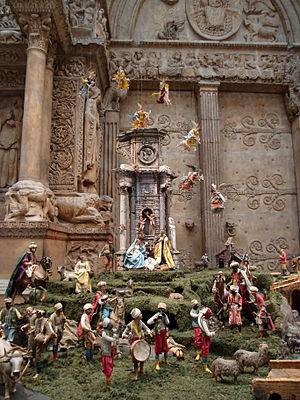
 IS THE SEASON… to strike the harp and join the chorus. One of my favorite pastimes in Christmastide is caroling with friends and family, accompanied by fine libations and delectable treats. Like the real wax candles that bedeck our family Christmas tree, though, caroling seems to have become an anomaly in the modern world—a bizarre ritual of old that delights the anthropologist but is of little other use. Christians as much as anyone else simply turn on the radio and think little more of it. Ask the average person in your parish to sing the first verse of Silent Night from memory and I wager he hasn’t got the mental reserve to make it half way through. Don’t doubt me.
IS THE SEASON… to strike the harp and join the chorus. One of my favorite pastimes in Christmastide is caroling with friends and family, accompanied by fine libations and delectable treats. Like the real wax candles that bedeck our family Christmas tree, though, caroling seems to have become an anomaly in the modern world—a bizarre ritual of old that delights the anthropologist but is of little other use. Christians as much as anyone else simply turn on the radio and think little more of it. Ask the average person in your parish to sing the first verse of Silent Night from memory and I wager he hasn’t got the mental reserve to make it half way through. Don’t doubt me.
In opposition to this decay, I thought today I might refresh our cultural memory of, and hopefully our desire for, the once ubiquitous Christmas carol. To be honest, how many even know what a carol really is, from whence these beautiful songs came and why they are so important—not only for creating a festive mood, but for forming the imagination of our young people (and not so young) and passing on the Faith?
Carols originated as circle dances, accompanied by singing, during the Medieval period. This dance-like quality (Angelus ad Virginem), as well as refrains (Birjina gaztetto bat zegoen, or The Angel Gabriel) and texts in either Latin (Quem pastores), the vernacular (Es ist ein Ros’ entsprungen) or both (Psalite, unigenito) were popular—traditions maintained in the modern era. Carol themes run the gamut of the liturgical year or might be secular in nature (Deck the Halls), although the Christmas carol seems to have taken the high ground. Their texts are beautiful examples of popular piety put into words, whether the carol narrates a well know Gospel text such as the Annunciation (The Salutation Carol) or speaks figuratively about the time Mary bore the Christchild in her womb (Maria durch ein Dornwald ging).
Carols developed around the same time as the great mystery and miracle plays (c. 1350-1450) in the golden age of Christendom (although no age is ever perfect) when the Church’s celebration of her liturgical life possessed the vitality to shape and form popular culture. Some carols, such as the Coventry Carol, were a part of these mystery plays.
European countries had a wonderful tradition of carols to which America contributed in her turn (It Came Upon a Midnight Clear and the Negro spiritual Rise Up, Shepherd and Follow), but in the last seventy-five years the carol has become nothing more than warm sentiments crooned on winter evenings by the latest pop stars emanating from every electronic device imaginable. I’ll gladly admit to listening to and enjoying Bing Crosby or Frank Sinatra singing Adeste fidelis (in an era when even the great Hollywood stars knew a bit of Latin) or I’m Dreaming of a White Christmas, backed by a large choir and orchestra, but this is an impoverishment of the original carol.
As our culture turns away from God, or more than likely, simply forgets about Him, the popularity of the carol has waned with the winter sun. I sometimes wonder if it isn’t partly the loss of the carol and many other worthy religious customs that has aided the demise of our Faith in the western world (and a loss of the true meaning of Christmas). I have noticed that parents who understand the importance of culture in the formation of their children and therefore instill in their children a healthy skepticism toward the benefits of “popular” culture are more successful in raising faithful children. Perhaps it would be wise for families to resist the urge to turn on the radio and tune in to the popular “winter holiday” songs and rather, rediscover the simple beauty of the Christmas carol, a true folk tune full of beautiful imagery, Christian meaning and wonderful melodies. Then learn them as a family and sing them together. Click here for a great printable (and free) Christmas caroling book or here to listen to five hours of wonderfully sung Christmas carols.
Keep the flame of the true Christmas spirit burning brightly, continue to wish your family and friends a Merry Christmas! and get together with those same beloved (and not so beloved) kin during the Twelve Days of Christmas and carol to your heart’s content. It is a wonderful way to instill in your children the real meaning of Christmas, to marvel at the beauty and awesomeness of the Incarnation and to create lasting memories. While you are at it, make a bowl of Smoking Bishop (be sure to have the spirits you put in it blessed today on the Feast of St. John) and toast our heavenly Father, Who in His infinite love sent His Son to become man so that we might become like God! Merry Christmas!

